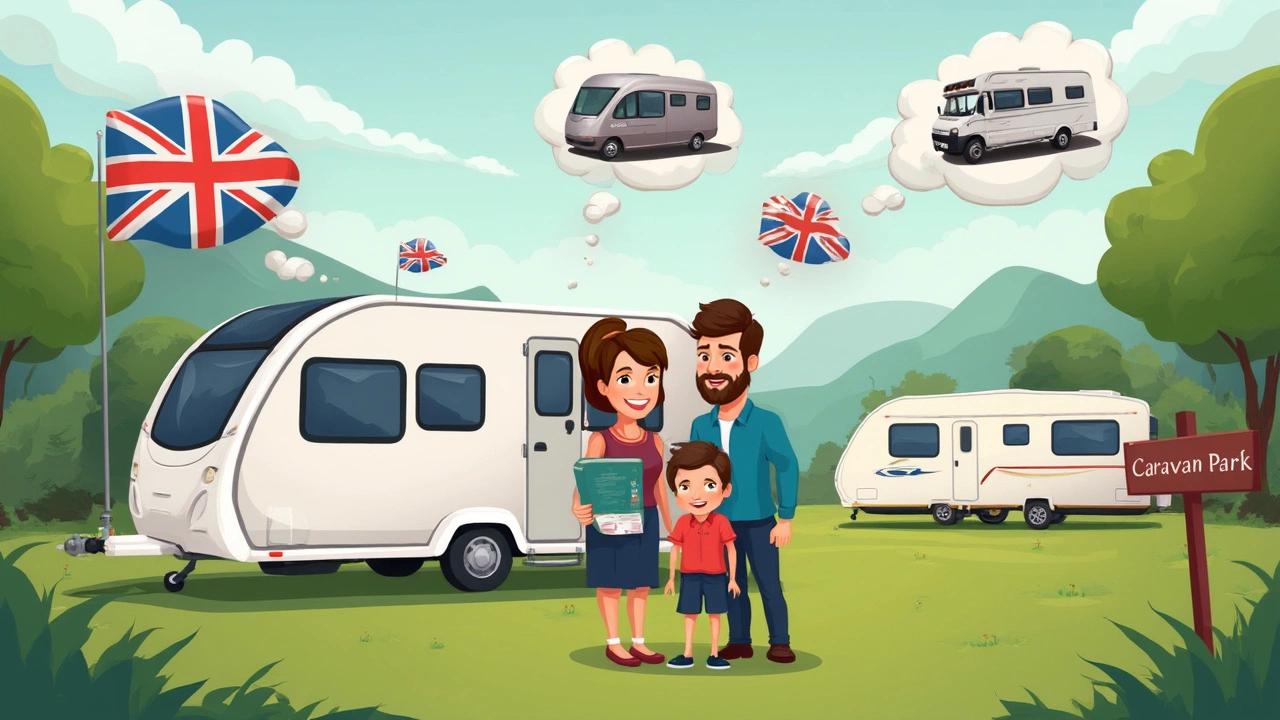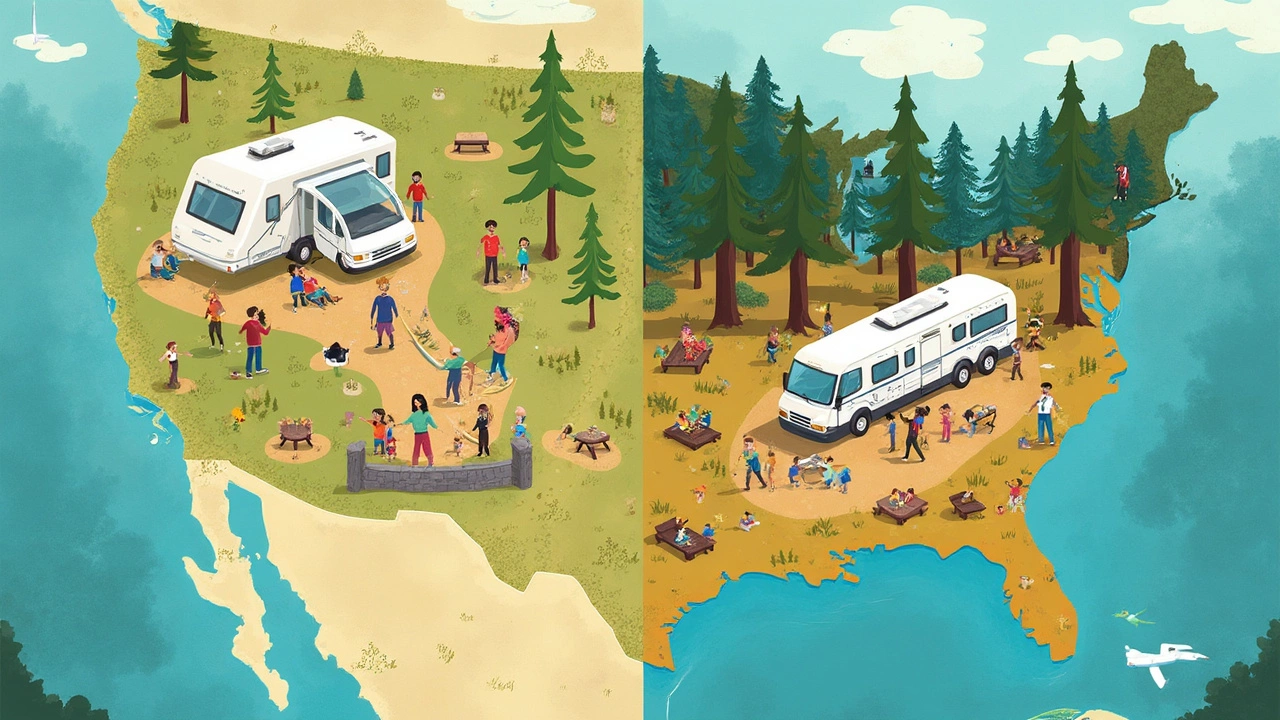What is a Caravan Called in America? Your Guide to Caravan Parks
 Jun, 22 2025
Jun, 22 2025
Ask an American about 'caravans,' and most will look a bit puzzled. Over here, nobody uses that word for a travel trailer. Instead, you’ll hear “RV,” short for recreational vehicle, or sometimes “camper” or “travel trailer.” If you’re booking a trip or parking at a campground, knowing this lingo is a life-saver.
The word ‘caravan’ just doesn’t pop up unless you’re binge-watching British TV or shopping for vintage Airstreams with a diehard fan. If you see 'caravan park' in America, that's a rare term—most places call them ‘RV parks’ or ‘campgrounds.’
Whether you’re looking to rent, buy, or just spend a weekend camping, understanding the differences helps you avoid some honest mistakes. Imagine calling up a U.S. campground and asking if they accept caravans. You might get a long pause—then a polite, “Could you repeat that?”
- Caravan or RV? Breaking Down the Lingo
- How Caravan Parks Work in the US
- Types of American RVs and Campers
- Tips for Navigating American Parks
Caravan or RV? Breaking Down the Lingo
Here’s the quick answer: in the U.S., you’re not going to hear “caravan” at all unless someone’s talking about the Dodge minivan (yep, really). When you mention a home-on-wheels, Americans say RV (recreational vehicle). The word RV covers everything from massive bus-sized motorhomes to smaller tow-behind trailers. It's a catch-all term, which makes life easier if you’re googling rentals or campground bookings.
Why the swap in words? Well, Americans have used “RV” since the 1910s and 1920s, when folks first started customizing cars and trucks for camping trips. Over in Australia and the UK, “caravan” stuck as the go-to. Geography shaped the lingo, but the idea's the same worldwide: a comfy space you tow or drive that lets you roam wherever you want.
Nailed the difference? Here’s a quick cheat sheet:
- RV: Anything used for camping on wheels (motorhomes, trailers, campers).
- Travel trailer: A specific type of RV you tow with a car or truck.
- Fifth wheel: A huge trailer, hitching over the back of a pickup truck bed.
- Camper van: Smaller, van-sized RVs—think big enough to stand in, but nimble enough for city streets.
- Motorhome: An RV with its own engine—no tow vehicle needed.
According to the RV Industry Association, over 11 million U.S. households own an RV. That’s not just boomers or retirees either—the 2023 Statista survey found nearly half of RV owners are under 55. Road trips are back in style, and knowing the language makes planning easy.
| Term (US) | Rough British/Aussie Equivalent | Main Use |
|---|---|---|
| RV | Caravan or Motorhome | Generic for all camping vehicles |
| Travel Trailer | Caravan | Towed living space |
| Camper Van | Campervan | Drivable, compact RV |
| Motorhome | Motorhome | Large, self-propelled RV |
As Jeff Crider from RV News once put it,
“Asking for a caravan in the U.S. will get you odd looks—RV is the word that takes you places.”
So, remember: say RV, and you’ll fit right in at any American campground.
How Caravan Parks Work in the US
If you’re hunting for a place to park your rig in America, don’t expect to see lots of signs saying ‘caravan park.’ Here, most folks use the term RV park or campground. These places are everywhere—from highway exits to lakeside getaways and even smack in the middle of the desert.
RV parks run the gamut. Some are packed with all the amenities—think Wi-Fi, swimming pools, laundry, and dog parks. Others are super simple, just a spot to pull in, hook up to some power, maybe water and a dump station. Here’s a quick peek at the kinds of hookups you’ll usually find:
- Full Hookup: Water, electricity, and sewer—everything you need for a comfy stay.
- Partial Hookup: Usually just water and power. You might have to empty your tank at a public dump station.
- Dry Camping: No hookups at all. You’re boondocking—living off your battery and tanks.
Pricing can surprise newcomers. National park campgrounds are usually cheaper—sometimes $20 to $35 a night—but often don’t have full hookups. Private parks can charge $40 to $100 per night, especially near busy tourist areas or cities.
| Type of Park | Typical Price per Night | Main Features |
|---|---|---|
| National/State Park | $20–$35 | Basic sites, limited hookups, nature access |
| Private RV Park | $40–$100 | Full hookups, Wi-Fi, social activities |
| Luxury RV Resort | $80–$150+ | Resort-style pools, gyms, golf, concierge |
Some parks let you book online, others are first-come, first-served, especially in state or national parks. The best sites fill up fast in vacation season, so plan ahead if you want a specific spot or view.
KOA Campgrounds CEO Toby O’Rourke says, "RVing in America is about flexibility — nearly 80% of travelers want parks with easy access to outdoor adventures and amenities to match their lifestyle."
It’s normal to see every kind of camper at these parks, from monster fifth-wheels to tiny pop-ups. Every park will have its own vibe, so check reviews online before you show up. It can make the difference between a peaceful mountain getaway and a noisy parking lot behind a truck stop.

Types of American RVs and Campers
When people mention RVs in the States, they’re talking about a big range of vehicles. It’s not just one style or size. Some let you stretch out with all the comforts of home, while others are more like a cozy tent on wheels. Knowing your options makes picking the right one way easier—especially if you’re calling up an RV park.
Here’s how the main types break down:
- Class A Motorhomes: Giant and flashy, these are the bus-looking RVs loaded with full kitchens, bathrooms, and even king-sized beds. Think luxury on the road.
- Class B Camper Vans: These are regular vans transformed inside with beds, toilets, and tiny kitchens. They’re easier to drive and park but have tighter spaces.
- Class C Motorhomes: A middle ground. They have a van front but a big overhead cab (the sleeping area that sticks out over the driver), so you’ll see a bit more living space without dealing with bus-size stress.
- Travel Trailers: These hook up to the back of your truck or SUV. You tow them from one spot to another, and some even pop out with extra bedrooms once you park.
- Fifth Wheels: These need pickup trucks with a special hitch in the truck bed. They have split-level layouts that some folks love—super roomy.
- Truck Campers: These slide right onto a pickup bed. Great for rougher terrains, but definitely a smaller living area.
- Pop-Up Campers: Light, low, and easy to pull. They fold down flat for travel, then pop up for sleeping space at camp. Not much luxury, but super practical if you just want to sleep inside.
You might be surprised by how popular RVing has become. According to the RV Industry Association, there were nearly 600,000 new RV units shipped in the U.S. in 2021—that’s a record year!
| Type | Length Range (Feet) | Average Sleeps | Towable? |
|---|---|---|---|
| Class A Motorhome | 26-45 | 4-8 | No |
| Class B Camper Van | 17-23 | 2-4 | No |
| Class C Motorhome | 20-33 | 4-8 | No |
| Travel Trailer | 10-40 | 2-10 | Yes |
| Fifth Wheel | 22-40 | 4-8 | Yes (bed hitch) |
| Truck Camper | 8-20 | 2-4 | Yes (pickup bed) |
| Pop-Up Camper | 8-16 | 2-6 | Yes |
Some folks swear by their particular RV style. As Bob Livingston, longtime RV writer, puts it:
"No matter what you drive or tow, there’s an RV that fits your taste and your budget—and once you find it, you’ll never want to travel any other way."
When picking an RV, think about not just the size, but also how easy it is to drive, how comfortable it’ll be to sleep, and whether you want a shower or just a place to crash. Prices can swing a lot—used pop-up campers might go for a few grand, while those fancy Class A’s easily top six figures.
Tips for Navigating American Parks
Finding your way around American RV parks isn’t all that complicated, but there are a few tricks that make the experience smoother. First off, book in advance, especially during summer and holidays. The best parks fill up quickly, and last-minute spots can be tough to grab in those peak months.
Many RV parks in the U.S. have different hookups for water, electricity, and sewage. Pull-through sites make parking a breeze, especially if you’re hauling a big rig. Double-check your RV’s size before booking—you don’t want to show up and realize your spot is too snug. Some parks only have space for smaller travel trailers or campers.
Most parks offer WiFi, but it’s not always strong. If being online is important, ask about their signal before committing. Also, state parks and national parks sometimes have stricter length limits and fewer amenities, but the scenery usually makes up for it. Here’s a quick look at what you’ll usually find at different types of parks:
| Type of Park | Average Nightly Rate (2024) | Hookups? | Max RV Length |
|---|---|---|---|
| Private RV Park | $45 - $85 | Full (water, electric, sewer) | 45 feet+ |
| State Park | $25 - $50 | Usually water & electric, not always sewer | 30-40 feet |
| National Park | $15 - $35 | Usually no hookups | 25-35 feet |
Most parks have quiet hours—usually around 10pm to 7am. Following these rules keeps everyone happy and avoids a late-night tap on your door from staff or rangers. If you’re bringing pets, make sure they’re allowed. Some fancy parks even have on-site dog parks, laundry, and mini golf.
- Always check-in during office hours if possible. Some parks lock their gates late at night or charge extra for late arrivals.
- Most places expect you to leave your spot as clean as you found it. Don’t dump gray or black water except in approved areas—big fines and dirty looks if you break this one.
- Get familiar with road signs in the park. Many are one-way, and some have strict speed limits (usually 5-10 mph) for everyone’s safety.
If you’re unsure about anything, don’t hesitate to ask the staff. Most are RV campers themselves and can point you to the best local food, hiking, or emergency mechanic.